

Unpacking fashion’s mental health problem. This week (May 16-22) is Mental Health Awareness Week, with “relationships” as the theme.
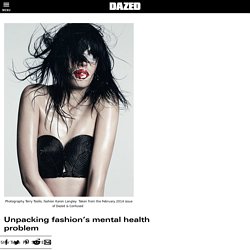
We’ll be running features all week about the mental health of those close to you, the mental health of the artists that inspire you and the different ways that communities and individuals deal with the issue. Slowly but surely, progress is being made in the ways in which we discuss a problem that affects each and every one of us. One in four people in the UK will experience a mental health problem each year and if you’re working in creative job, you’re 25 per cent more likely more likely to.
Naturally, this translates to fashion – an industry that has associations not only with the ‘tortured artist’, but with long hours and low pay, drama and Devil Wears Prada-like bosses, skipping meals and no sleep. But are these associations fair? Fashion industry. The creative brain, unravelled: how the highly pressured fashion industry is tackling mental ill-health. How the fashion industry has injured women: From killer heels to 'long scarf syndrome' During a routine experiment on 14 August 1996, Karen Wetterhahn, a 48-year-old chemistry professor at Dartmouth College who specialised in the study of toxic metal exposure, accidentally spilled a few drops of a mercury compound on her glove.

Less than a year later, she was dead. She believed that the latex gloves she was wearing would protect her and did not take them off immediately. Yet the "supertoxic" dimethyl mercury she was using soaked through her glove and entered her bloodstream in less than 15 seconds. Dr Wetterhahn did not have symptoms immediately, but after six months she started to have problems speaking, walking, hearing and seeing. Despite intensive medical treatment for mercury poisoning, she slipped into a five-month coma and then died on 8 June 1997.
Safety and health issues in the textile industry - Free Industry Articles - Fibre2fashion.com. The textile industry consists of a number of units engaged in spinning, weaving, dyeing, printing, finishing and a number of other processes that are required to convert fibre into a finished fabric or garment.

There are several safety and health issues associated with the textile industry. This article aims at studying each of these issues in relation to the US and Indian textile industries in detail, along with the possible solutions for these problems. The major safety and health issues in the textile industry can be stated as under: 1) Exposure to cotton dust. Fashion matters… in mental health. One in four people in the UK will experience a mental health problem each year and if you’re working in creative job, you’re 25 per cent more likely to.
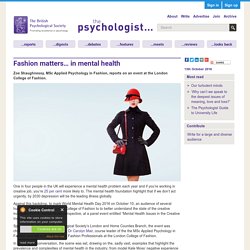
The mental health foundation highlight that if we don’t act urgently, by 2030 depression will be the leading illness globally. Against this backdrop, to mark World Mental Health Day 2016 on October 10, an audience of several hundred gathered at the London College of Fashion to to better understand the state of the creative industries from a mental health perspective, at a panel event entitled “Mental Health Issues in the Creative Industries.” Sponsored by the British Psychological Society’s London and Home Counties Branch, the event was chaired by Chartered Psychologist Dr Carolyn Mair, course leader of the the MSc Applied Psychology in Fashion and MA in Psychology for Fashion Professionals at the London College of Fashion. Fashion matters…in Mental Health, words by Zoe Shaunessy.
Fashion matters…in Mental Health words by Zoe Shaunessy One in four people in the UK will experience a mental health problem each year and if you’re working in creative job, you’re 25 per cent more likely to.

The Mental Health Foundation highlight the fact that if we don’t act urgently, by 2030 depression will be the leading illness globally. Against this backdrop, to mark World Mental Health Day 2016 on October 10, an audience gathered at London College of Fashion to to better understand the state of the creative industries from a mental health perspective, and suggest potential solutions, at a panel event entitled “Mental Health Issues in the Creative Industries.” Sponsored by the British Psychological Society, the event was chaired by Dr Carolyn Mair, CPsychol AFBPsS and MSc Applied Psychology in Fashion and MA in Psychology for Fashion Professionals course leader.
The Fashion Industry Has a Health Problem. And That's a Labor Issue. Does Fashion Have a Mental Health Problem? LONDON, United Kingdom — Aristotle said: “No great genius has ever existed without a strain of madness.”

In the fashion industry, the existence of a link between creative genius and mental ill health has long been a matter of debate. Certainly, some of the industry's top designers have struggled with mental health issues. 10 Truly Oppressive Working Conditions Of The Clothing Industry. Whether you pay attention to fashion trends or not, we all wear clothes on a daily basis.

Fashion is a multibillion-dollar industry. With the growing demand for extremely cheap clothing prices in the Western world, the money for materials, labor, and shipping has to come from somewhere. It would be impossible to achieve the abundance of fashion available at our fingertips without running into some major issues. 10. Child Labor. Reforming sweatshop Taiwan no easy job. Last year, the Organisation for Economic Co-operation and Development (OECD) released statistics on the average annual number of hours worked per worker.
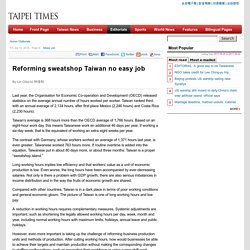
Taiwan ranked third, with an annual average of 2,134 hours, after first-place Mexico (2,246 hours) and Costa Rica (2,230 hours). Taiwan’s average is 368 hours more than the OECD average of 1,766 hours. Based on an eight-hour work day, this means Taiwanese work an additional 46 days per year. If working a six-day week, that is the equivalent of working an extra eight weeks per year. The contrast with Germany, whose workers worked an average of 1,371 hours last year, is even greater: Taiwanese worked 763 hours more. Inside the horrific unregulated sweatshops of Bangladesh. These are the photographs that show the grim reality for thousands of children in Bangladesh who are forced to work long crippling hours stitching labels into clothes.
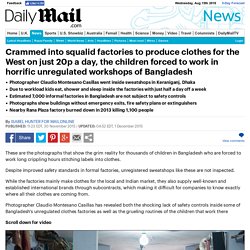
Despite improved safety standards in formal factories, unregistered sweatshops like these are not inspected. While the factories mainly make clothes for the local and Indian market, they also supply well-known and established international brands through subcontracts, which making it difficult for companies to know exactly where all their clothes are coming from. Photographer Claudio Montesano Casillas has revealed both the shocking lack of safety controls inside some of Bangladesh's unregulated clothes factories as well as the grueling routines of the children that work there Scroll down for video. Sweatshops in Bangladesh. In Bangladesh, 3.5 million workers in 4,825 garment factories produce goods for export to the global market, principally Europe and North America.
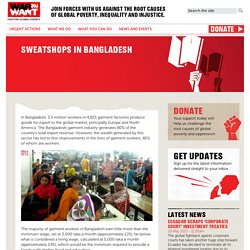
The Bangladeshi garment industry generates 80% of the country’s total export revenue. However, the wealth generated by this sector has led to few improvements in the lives of garment workers, 85% of whom are women. The majority of garment workers in Bangladesh earn little more than the minimum wage, set at 3,000 taka a month (approximately £25), far below what is considered a living wage, calculated at 5,000 taka a month (approximately £45), which would be the minimum required to provide a family with shelter, food and education.
As well as earning a pittance, Bangladeshi factory workers face appalling conditions. Many are forced to work 14-16 hours a day seven days a week, with some workers finishing at 3am only to start again the same morning at 7.30am. Wcms 300463. Working conditions in the global fashion industry. The $450 billion global fashion industry is one of the most important sectors of the global economy that creates jobs and clothes for people all over the world. It employs over 25 million workers in over 100 countries. The reality of this industry is that many individual producers in the developing countries work long hours under strenuous conditions for pennies on the dollar, far less than a living wage.
However, there exist many unacceptable working conditions which will be illustrate in the following. A major concern among garment workers are long working hours and forced overtime. Employees normally have to work between 10 to 12 hours, sometimes 16 to 18 hours a day. Meet the New Generation of Robots for Manufacturing. A new generation of robots is on the way—smarter, more mobile, more collaborative and more adaptable. They promise to bring major changes to the factory floor, as well as potentially to the global competitive landscape. Robots deployed in manufacturing today tend to be large, dangerous to anyone who strays too close to their whirling arms, and limited to one task, like welding, painting or hoisting heavy parts.
The latest models entering factories and being developed in labs are a different breed. They can work alongside humans without endangering them and help assemble all sorts of objects, as large as aircraft engines and as small and delicate as smartphones. Soon, some should be easy enough to program and deploy that they no longer will need expert overseers.
WA fashion designers struggle due to high manufacturing costs. By Hayley Roman Updated Perth fashion designer Poppy Lissiman is the latest casualty of Western Australia's high manufacturing costs. She's produced her fashion label in Perth's suburbs since 2008 but the clothing line is now on-hold indefinitely. "It's just getting too expensive unfortunately," she said. Enterprise Nation. Alison Lewy, author of Design Create Sell, our new guide for fashion start-ups, has already talked about how you go about selecting the right manufacturer for your fashion business. But should you use a UK supplier or one based overseas? The benefits of producing overseas 1. Costs: offshore production is generally more cost-effective, especially when producing large volumes.
Offshoring Apparel Making,Offshore Clothing,Offshore Apparel,Offshore Garment Manufacturing,Offshore Clothing Suppliers. Apparel makers prefer to keep their manufacturing activities offshore; to utilize cheap labor costs. But on the other side, the same is characterized by longer lead times, and more upfront cash investment. While retailers are expecting quick response to their orders, how good is it for an apparel maker to offshore their operations; and to what extent? Apparel making is the engine of textile business for any country. To take advantage of low costs, apparel makers nowadays offshore their manufacturing operations. Manufacturing - Sustainability in the Fashion Industry. Evaluating offshore and domestic production in the apparel industry: The small firm’s perspective. The humble life of Zara owner Amancio Ortega is to be admired.
Opportunities and Challenges in Asia's Apparel and Textile Sector. Exposing Asia’s Fashion Empires. West's fashion industry relies on sweat of Asia's teenagers. The fashion capital of Latin America - The Report Company. Ms-thesis-abstract.pdf. Fashion In Latin America: Then and Now. 140841REV1-Workers-conditions-in-the-textile-and-clothing-sector-just-an-Asian-affair-FINAL.pdf. How the fashion industry can empower women in South Asia. Africa - Emerging creator and consumer of luxury goods and fashion. What will it take for Africa to join the global fashion system?
Panelists call for support to Africa’s fashion industry. Africa's Fashion Industry: Challenges, Opportunities. London Fashion Week - News. The 10 Biggest Exporting Countries in the World. Textile Fabrics Industry Overview Trends & Growth Report. Leading 15 textile exporters worldwide in 2013, by country. Textile World Asia - Country Profiles. Fast Fashion Is the Second Dirtiest Industry in the World, Next to Big Oil. A Must-Watch Fast Fashion Documentary Is Now On Netflix.
30 Fair Trade Clothing Brands That Are Betting Against Fast Fashion — The Good Trade. The True Cost Documentary - Fast Fashion, Sustainable Production. 5 Truths the Fast Fashion Industry Doesn't Want You to Know FastFashionSustainability.pdf. Welcome to Forbes. Textiles in Asia Pacific - Manufacturing Opportunities. Perception Vs Reality. The Growth Factory. Evaluating offshore and domestic production in the apparel industry: The small firm’s perspective.
Offshoring Apparel Making,Offshore Clothing,Offshore Apparel,Offshore Garment Manufacturing,Offshore Clothing Suppliers. Manufacturing Offshore Is Bad Business. The%20Economic%20Impact%20of%20the%20Fashion%20Industry%20. EURATEX: Key data. 30 Shocking Figures and Facts in Global Textile and Apparel Industry. Global fashion industry statistics - Fashion News, Business, international apparel industry world wide. Fashion : Spotlight on Statistics. 25 Shocking Fashion Industry Statistics. 35 realities of working in the fashion industry. Fashion. Balderton leads $8m investment in Thread. Fashion industry.